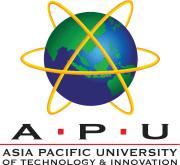Asia Pacific University of Technology & Innovation
|
Universiti Teknologi dan Inovasi Asia Pasifik | |
 | |
Former names | Asia Pacific Institute of Information Technology (1993 - 2004)[1] |
|---|---|
| Motto | Nurturing Professionals[2] |
| Type | Private[3] |
| Established | 1993[4] |
Parent institution | APIIT Education Group |
| Chairman | Datuk Dr. Parmjit Singh[5] |
| Vice-Chancellor | Prof. Ron Edwards[6] |
| Location |
Bukit Jalil, Kuala Lumpur, Malaysia |
| Campus |
Urban 11.7 acres (4.7 ha) |
| Abbreviation | APU |
| Colours |
Verdigris, Alizarin & Sun [7] |
| Nickname | Legends |
| Affiliations | |
| Website |
www |
The Asia Pacific University of Technology and Innovation (abbreviated as APU) is a private university in Malaysia. It was formed in 1993 as the Asia Pacific Institute of Information Technology (APIIT) and was renamed in 2004 after being granted University College status to Asia Pacific University College of Technology and Innovation (UCTI).[3] It has produced more than 40,000 graduates[4] under APIIT with association of Staffordshire University.[8]
APU provides undergraduate and postgraduate programs in the areas of information technology, media, business and engineering. APU has opened overseas branches in India,[9] Sri Lanka[10] and Pakistan,[11] although these branches are still under APIIT branding. APU was announced as among the Highest Rated Emerging Universities in Malaysia, being rated at 5-STAR (EXCELLENT Rating) under the SETARA 2017 Ratings by the Ministry of Higher Education (MOHE). APU has maintained this Excellent Rating in the SETARA 2011, 2013 and now in 2017. SETARA 2017 5-Star Rating was presented by the Minister of Higher Education Malaysia. The university and its students have received awards, such as the NAPEI Education Excellence Award 2007 (University Category),[12] the Microsoft Imagine Cup Malaysia 2011,[13] the Prime Minister's Award for Industry Excellence 2011.,[14] etc. Other research and development activities are carried out on the campus. 51% of its shares are owned by Ekuiti Nasional Berhad[15]
History
Asia Pacific Institute of Information Technology (APIIT) was founded in 1993 as part of an initiative by the Malaysian Government to address the shortage of IT Professionals in the country. The newly formed institute was based in Damansara Heights, Kuala Lumpur and offered Diploma courses in computing and IT. In the following year, co-operative links were established with Monash University in Australia, leading to the launch of a twinning program in 1995 for Bachelor's degrees. in 1996 they make a partnership with Staffordshire University in UK.Expansion led to the opening of the Kuala Lumpur city campus in 1997, followed by campuses in Karachi, Pakistan (1998), Colombo, Sri Lanka (2000), Lahore, Pakistan (2000), Panipat, India (2001) and Perth, Australia (2004). In 2003 the Malaysian campus moved to new premises at Technology Park Malaysia, where it is now known as APIIT TPM.
The curriculum has developed, with the Institute becoming a SUN and Microsoft authorized training center in 1998, a SAP University Alliance Partner in 1999 and a Microsoft Certified Technical Education Center in 2001. APIIT gained university college status in 2004 and was renamed to Asia Pacific University College of Technology & Innovation (UCTI) and later to Asia Pacific University of Technology & Innovation (APU).
Organisation
The University is divided into eight schools:[16]
- School of Accounting, Finance and Quantitative Studies
- School of Business and Management
- School of Computing and Technology
- School of Engineering
- School of Foundation
- School of General Studies
- School of Media, Arts and Design
- School of Postgraduate Studies
Student life
Actives and representative council
The Asia Pacific University Student Activities and Representative Council, better known as The Student ARC is the official students' union that handles the 5 major events of the year as well as represents the students, clubs and societies in any inter-varsity events or collaborations. The SARC student body is elected in January by the students of the university for the term duration of 1 year. Although unlike most student council, the SARC do not represent the students in the University's decision-making process and is governed by Department of Student Affairs which acts as an advisory board.[17]
See also
References
- ↑ Article about APU History
- ↑ Official Video Commercial of Asia Pacific University of Technology & Innovation
- 1 2 "Expatriate Malaysia Education Guide – APU – Asia Pacific University of Technology & Innovation Malaysia". expat.com.my. Retrieved 19 December 2011.
- 1 2 "APIIT – History". APIIT. Archived from the original on 11 December 2011. Retrieved 19 December 2011.
- ↑ Ekuinas Launching ILMU Education Group
- ↑ Article about IEE Inauguration in APU
- ↑ "The University". apu.edu.my. Retrieved 3 January 2017.
- ↑ "Staffordshire University – UCTI – International Partnership Students Graduate". Staffordshire University. Retrieved 19 December 2011.
- ↑ "About APIIT India". APIIT. Retrieved 19 December 2011.
- ↑ "About APIIT Sri Lanka". APIIT. Archived from the original on 3 December 2011. Retrieved 19 December 2011.
- ↑ "APIIT branch at Karachi, Pakistan". APIIT. Archived from the original on 30 December 2011. Retrieved 19 December 2011.
- ↑ "DEVELOPMENT OF PRE-PROGRAMMED OPERATING COURSEBOT FOR UCTI(UNIVERSITY COLLEGE OF TECHNOLOGY & INNOVATION)(Company origins section)" (PDF). Universiti Teknologi Malaysia. Retrieved 19 December 2011.
- ↑ "UCTI team wins Imagine Cup with cancer care system". The Star (Malaysia). Retrieved 19 December 2011.
- ↑ "Best in industry". The Star (Malaysia). Retrieved 19 December 2011.
- ↑ "UCTI – R&D Achievements". UCTI. Archived from the original on 16 November 2011. Retrieved 19 December 2011.
- ↑ "E-Brochures". Asia Pacific University. Retrieved 22 January 2017.
- ↑ "APU Student ARC". APU Student Affairs. Retrieved 22 January 2017.
External links
| Wikimedia Commons has media related to Asia Pacific University of Technology and Innovation. |
Coordinates: 3°02′53″N 101°41′33″E / 3.04806°N 101.69250°E